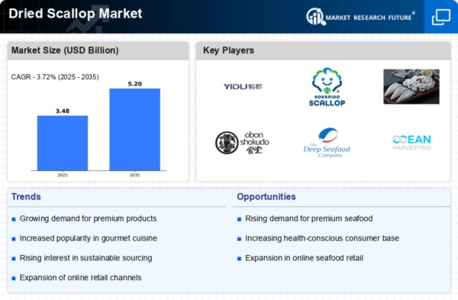Rising Seafood Consumption
The Dried Scallop Market is poised for growth due to the rising consumption of seafood products. As consumers become more health-conscious, they are increasingly turning to seafood as a source of lean protein and essential nutrients. Data shows that seafood consumption has been on an upward trajectory, with dried scallops being a preferred choice for their rich flavor and nutritional benefits. This trend is particularly evident in regions where seafood is a staple, indicating a robust market potential. The Dried Scallop Market may see a significant boost as more consumers incorporate dried scallops into their diets, driven by the health benefits associated with seafood.
Culinary Versatility and Demand
The Dried Scallop Market benefits from the culinary versatility of dried scallops, which are increasingly favored in various cuisines. Chefs and home cooks alike appreciate the unique umami flavor and texture that dried scallops impart to dishes. This versatility has led to a rising demand in restaurants and food service establishments, where dried scallops are used in soups, risottos, and gourmet dishes. The market data indicates that the culinary sector is projected to grow, with an increasing number of restaurants incorporating dried scallops into their menus. This trend suggests that the Dried Scallop Market is likely to experience sustained growth as culinary innovation continues to thrive.
Expansion of Asian Cuisine Popularity
The Dried Scallop Market is significantly influenced by the growing popularity of Asian cuisines, particularly in Western markets. Dried scallops are a staple ingredient in many Asian dishes, such as congee and stir-fries, and their incorporation into mainstream culinary practices is on the rise. This trend is supported by an increasing interest in diverse culinary experiences among consumers. Market data indicates that Asian food products are experiencing a surge in demand, which bodes well for the Dried Scallop Market. As more consumers seek authentic Asian flavors, the market for dried scallops is likely to expand, driven by this cultural culinary exchange.
Innovations in Preservation Techniques
Innovations in preservation techniques are transforming the Dried Scallop Market. Advances in drying methods, such as freeze-drying and vacuum drying, enhance the quality and shelf life of dried scallops. These techniques not only preserve the flavor and nutritional value but also improve the overall safety of the product. As consumers become more discerning about food quality, the demand for high-quality dried scallops is likely to increase. Market data suggests that companies investing in advanced preservation technologies may gain a competitive edge, positioning themselves favorably within the Dried Scallop Market. This focus on quality and safety could drive further growth in the sector.
Increased Focus on Sustainable Practices
The Dried Scallop Market is witnessing a heightened focus on sustainable fishing and sourcing practices. As consumers become more environmentally conscious, they are increasingly seeking products that align with their values. This shift has prompted suppliers to adopt sustainable practices, ensuring that dried scallops are sourced responsibly. Market data suggests that products labeled as sustainably sourced are gaining traction among consumers, leading to a potential increase in sales for the Dried Scallop Market. Companies that prioritize sustainability may not only enhance their brand image but also tap into a growing segment of eco-conscious consumers, thereby driving market growth.



.webp)
.webp)
.webp)
.webp)
.webp)
.webp)








Leave a Comment